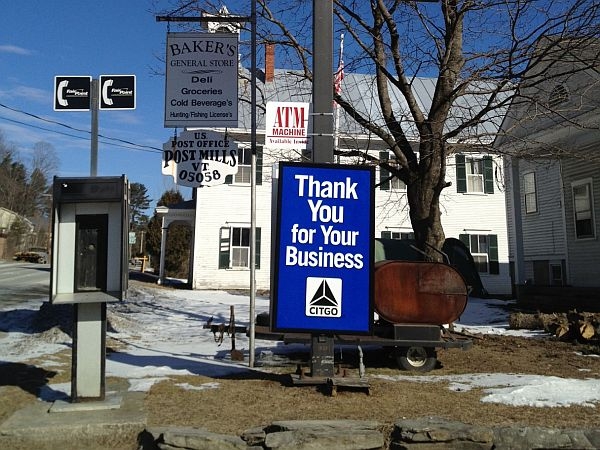
The state is encouraging towns throughout Vermont to bring their land use plans in line with regional plans.
In some cases that means changing local zoning districts. One goal is to prevent strip development in rural areas.
The Upper Valley village of Post Mills has been discussing the issue.
Head northwest from Thetford on Route 113, and after a few miles of rolling pasture you see Baker’s General Store, which has gas pumps and a post office window.
There’s a hair salon next door, and a tiny airport to the east. But there is no "strip" development leading into or out of Post Mills.
Peter Gregory, director of the regional planning commission that serves this and 29 other communities, says one way to prevent sprawl is to re-draw the planning map to make the village residential zone smaller and perhaps denser than it is now.
"They’d be changing their land use and then ultimately their zoning to reflect the fact that commercial uses would not be allowed along the highway strip but would only be allowed within the village, the dense mixed use area of Post Mills Village," Gregory said.
Inside the General Store-arguably the village’s only one-stop "mixed use" facility–owner Mike Pomeroy says regional planners are unduly worried about sprawl in his sleepy little town.
"I find that ludicrous, you know, it’s the fear factor," Pomeroy said. "But what annoys me the most is that the state and the regional let the town go through this very lengthy process, and I mean they had public meetings with all the villages, they did very good due diligence, asking the people what they wanted for zoning, let us go through the whole process, we pass the zoning, and then after the fact they said, ‘Oh, by the way, you did it wrong.’"
But Peter Gregory, of the regional planning commission, says it’s not a question of right or wrong. He says it’s just a matter of making sure that local plans align with regional plans.
If a town does not comply, he says, it can lose planning money from the state. He says regional planners have looked at about 21 town plans in this region. About 12, he says, have some issues to resolve, and eight are making changes.
"It’s this kind of dialogue that we need to have all across Vermont at the planning stage so when we get to permitting, whether it’s local permitting or Act 250 or the difference between local and Act 250, we don’t have conflict playing out. So this has been a great thing and we’ve been pleased to participate in the discussions," Gregory said.
Post Mills Planning Committtee Chairman Kevin O’Hara agrees. But he says the town plan must be changed carefully.
For example, the allowable residential lot size inside the village is smaller than outside the village. If zoning changes, some current village property owners would suddenly find themselves in the rural residential zone, where minimum lot sizes must currently be bigger, and commercial uses are more restricted.
"If we only stayed with rural residential and village residential as two options you know, we’d arguably end up with fewer options to do something with their property in terms of subdivision," O’Hara said.
O’Hara says the town may consider adding another zone-but he notes that would require a lot more hearings and meetings. In general, he says people are not opposed to the goal of preventing strip development and sprawl in the rural Upper Valley. They just don’t all agree with the regional commission on how to achieve it.